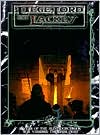

 |

|

The average rating for Liege, Lord, and Lackey based on 2 reviews is 3 stars.
Review # 1 was written on 2012-06-28 00:00:00 Robin Datta Robin DattaDark Ages Mage is the first book in my attempt to review the entire Mage line before the 20th Anniversary Edition comes out. Mostly, it's my way of keeping sane while I wait. This is going to be an interesting one, because I never actually got around to reading Dark Ages ANYTHING before, and I've heard many times that Mage and Fae are both things of beauty. As for why I'm starting here, I'm going in "chronological order" based one when the book is set, with the assumption that the books under Mage: the Ascension were all set in the years they were written. So, Dark Ages first, then Sorcerer's Crusade, and then on to Ascension, with the big restriction that, of course, I don't actually HAVE every book. The book starts out with a nice little piece of fiction involving a treacherous nobleman and how his treachery leads to the formation of a cabal. The fiction is well-written and kept hold of me (something that's often been a problem with my attempts to read the fiction in Mage books before) and served as a good lead in to the book. Chapter 1: Magic and the Medieval focuses on the myths, legends and superstitions of Medieval life. I can't speak for too much in the way of authenticity, except when speaking of the Jewish mysticism (Kabbalah and Gematria) which is handled quite well. In general, White Wolf seemed to handle Judaism much better than it did some other cultures (also look on to Charnel Houses of Europe from the Wraith line for another excellent example) and I'm hoping that Mage 20 handles the mysticism comparably well, and from what Brucato has said on Facebook, we can expect this level of accuracy across the board. Chapter 2: Mystic Fellowships goes into detail on the six major factions of mages of the era: the Ahl-i-Batin, the Messianic Voices, the Old Faith, the Order of Hermes, the Spirit-Talkers and the Valdaermen. Each of them gets six full pages of exposition! The biggest issue I have is that these six pages aren't equal. The Ahl-i-Batin schools get a sidebar discussing what they're about. The Houses of Hermes, however, aren't even listed by name, only Tremere (now a Clan) and Quaesitor are given even a specific mention! The impression it really gives me is that they're afraid of Ars Magica in some way, even though the Dark Medieval and Mythic Europe are radically different in tone, and the Houses will not be the same across the two games, plus, many WoD players won't have the Ars Magica books to fill this gap. The real strength, though, is the Valdaermen, a Norse group of magi, who mix some bits of Cultist and Verbena mythology, with one of the most boastful stereotypes of another faction I've read in their opinions on the Order, which I'll not quote, so that people have to get the book to read it. Chapter 3: Characters is pretty much what you expect. It's a solid description of character creation with some basic stats included. It's short, because it can offload most of the work to Dark Ages: Vampire, but overall, it was passable, and set up: Chapter 4: Magic. Here's the real meat of the book, the magic system is fundamentally different from Ascension's. Each Mystic Fellowship has a Foundation, which is analogous to Arete and informs how they think about magic and four Pillars which are their mystical knowledge. While this system has many benefits, and makes it VERY clear how different the fellowships ARE, it has a downside: it's not very expandable. The Sphere system can just be adopted by any mage, and you change the paradigm, whether they're a Tradition mage or Orphan or anything in between. The Pillars need to be worked out in detail for any other mystical fellowship. This is in part because for high levels of the Foundation, there are always on game mechanical benefits, but it does make it harder to expand the system. Chapter 5: Magical Lands is a mystic geography covering Britain, Scandinavia, Italy, Spain, Eastern Europe and more. It covers many specific crays (nodes in Ascension terms) and also Hedge mages, such as the Rosselini and Giovanni families from Vampire: the Masquerade, as well as dealings with the Fae (in Britain, including King Arthur) and a rather large expansion on the Valdaermen. Chapter 6: Creatures and Talismans starts out strong with Dragons, and then moves on to Unicorns, Fae, some undead, the Umbra...all in all, a strong chapter with a good toolbox even for rare creatures and items that survive to the present day. Chapter 7: Storytelling does what it sets out to go: give the ST some help getting things going. It discusses theme, mood, some setting material and plot hooks. Overall, Dark Ages: Mage surprised me. I wasn't expecting to like the book as much as I did, and if I'd gone through it before, when I ran a story for a Hermetic where they went back in time to the Dark Ages, I might have used Dark Ages rather than Ars Magica, save for the fact that the Hermetics only appear at low resolution in the book for some reason. |
Review # 2 was written on 2014-02-07 00:00:00 Per-anders Broberg Per-anders BrobergI have to admit that I don't understand the motivation behind this version of Mage unless White Wolf wanted to fill the void of Ars Magica, which covered much the same ground. Of course, the company didn't develop the line very far beyond this volume either. |
CAN'T FIND WHAT YOU'RE LOOKING FOR? CLICK HERE!!!